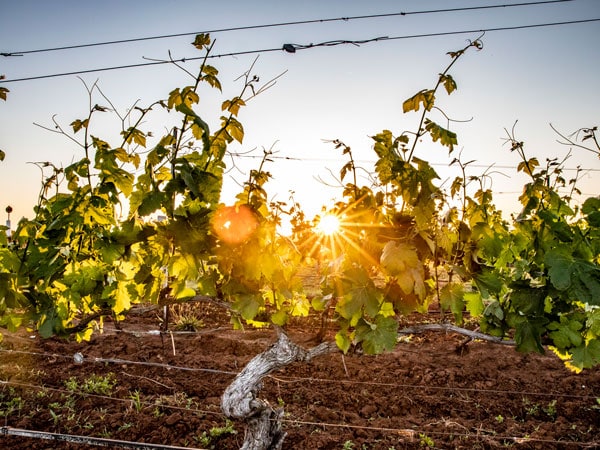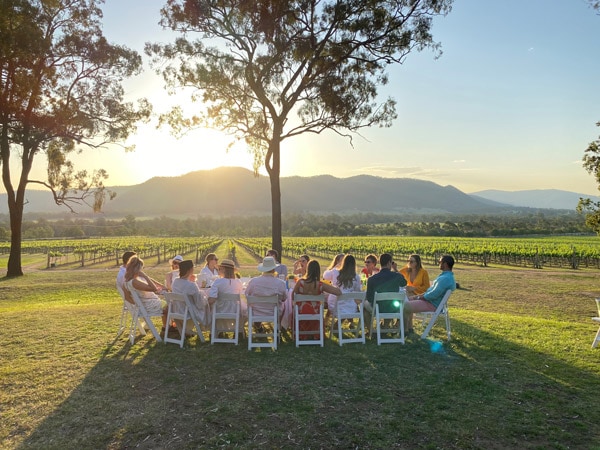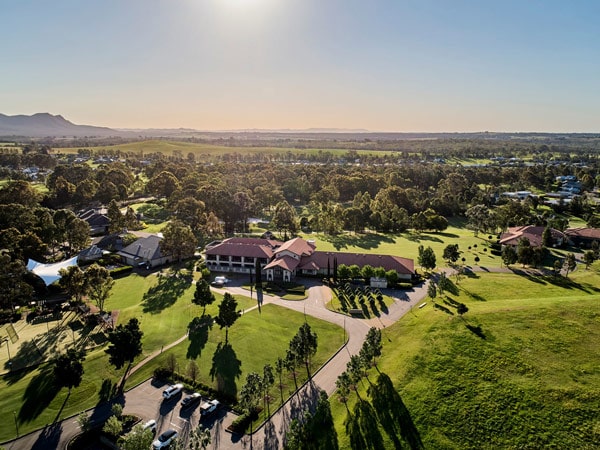30 October 2023
![]() 12 mins Read
12 mins Read

There are certain points during a trip to the Hunter Valley that make you feel like you’ve stepped straight into a Frederick McCubbin painting. The Australian impressionist captured in brushstrokes an early Australian pastoral ideal in all its tawny shades of green and burnished golds offset by a blue sky or a marbled sunset. And despite being Australia’s most popular wine region, just over two hours from Sydney and an even quicker skip down the road from Newcastle, the Hunter still serves up these vistas in abundance and quick succession: revealed once you round a bend en route from one winery to another, kangaroos grazing in the grasses in your periphery.
Traditional Lands of the Wonnarua people and encompassing 2605 hectares of vineyards, the Hunter is a patchwork of smaller subregions each with its own nuances in terms of wine characteristics. I join a gathering at Carillion Wines at Tallavera Grove to celebrate the 16th annual Hunter Valley Legends Awards, which recognises the region’s past, present and future.

The sun rises over vineyards in Australia’s oldest wine country, the Hunter Valley. (Image: Destination NSW)
Here in Mount View, in what has poetically been described as the dress circle of the Hunter Valley, vines grow on terra rossa soils derived from underlying limestone that you’d more readily associate with South Australia’s Coonawarra cabernet sauvignon than in a glass of classic Hunter semillon, verdelho, chardonnay or shiraz. Such is the surprise you can still find here. And, as we look out towards the vineyards cushioned by rolling hills, the bucolic vista belies the region’s urban proximity. “Welcome to this beautiful part of the valley,” says chef Robert Molines of adjoining restaurant Bistro Molines, gesturing to the view. “That’s why we turn up every day.”

Stroll along Hunter Valley’s picturesque vineyards. (Image: Destination NSW)
With vines first planted from 1828, and on the map as a wine region both locally and internationally by the late 1800s, the Hunter Valley is Australia’s oldest and most visited surviving commercial wine region. Famous Australian wine names such as Wilkinson and Tyrrell are among the pioneering families still rooted in Hunter winemaking tradition today. And as I stand here right now among legends, including fourth-generation winemaker Bruce Tyrrell, I contemplate what has changed and what has stayed the same.

Tyrrell’s Wines was founded in 1858 and is one of the region’s pioneering wineries. (Image: Destination NSW)
A further revelation comes in the shape of another subregion of the Hunter Valley. Just 20 minutes from the hub of Pokolbin, where you’ll find institutions such as Brokenwood and Tyrrell’s, Broke Fordwich feels a world away. With unique basalt- and iron-rich soils producing idiosyncratic wines, it even has its own Geographical Indication (GI).
The landscape, framed by ridges and mountains, opens up into those McCubbin vistas again. “Isn’t this God’s country?” asks our driver, Peter Butler of Rover Coaches, emphatically. An old romantic who’s ever-ready with a story of a Hunter proposal or wedding, he loves to bring guests to this pocket of the valley: “People don’t know it’s here.”

Shiraz and cabernet sauvignon are among the red varietals in Hunter Valley vineyards.
Dotted with small, passionate businesses, Broke retains an indie streak. At Running Horse Wines, David Fromberg pours tastings to a soundtrack of alternative music while views of the equine-dotted paddocks flood in through huge shipping-container windows.
Family-run BARE Nature’sKin is an eclectic apothecary where you can stock up on handmade soaps and olive oil. French-inspired Krinklewood Estate is the Hunter’s first certified biodynamic winery: peacocks saunter between tables dotted around the sun-dappled courtyard while patrons linger over a cheese platter and basket press shiraz.

A peacock struts around Krinklewood Estate. (Image: Nikki To)
“We have a great community,” says Karin Adcock, Winmark Wines owner and vigneron, who was instrumental in establishing a wine trail through the area. “It’s such an important thing for us to have a good wine trail that shows the world there’s a reason to come to Broke and many good places to visit. There’s a really good camaraderie between the vineyards and people are happy to help and share their knowledge.”

Sip chardonnay in the sun at the cellar door of the year Winmark Wines.
Winmark Wines is fresh from winning Cellar Door of the Year at the 2023 Hunter Valley Legends Awards. Karin is breaking the mould with a winery – which translates to Field of Vines in her native Danish – dedicated solely to making best-in-class chardonnay with the help of leading viticulturist Liz Riley and vineyard manager David Grosser.

Take in magical views over Yellow Rock and the Broke Fordwich wine region.
The mission? To introduce drinkers to the versatility of modern chardonnay (and banish any oak-driven preconceptions). The winery, which sits at the base of Yellow Rock, also does triple duty as an art gallery and accommodation complete with a tiny home and guest houses whose walls are lined with paintings; Karin, who brought Pandora jewellery to Australia, is an avid collector of art and sculpture.
That Karin doesn’t come from a winemaking background adds to the winning equation: she questions and innovates. And, from the boutique cellar door in the old storage shed to the barista coffee cart, activities for kids and sculpture walk, everything here is executed impeccably. “What gets me out of bed in the morning? Making people happy through exceptional experiences,” says Karin.
It hasn’t quite nudged midday when I’m sipping chardonnay and eating homegrown olives pickled in fennel while looking out over the vines as Rosie the mini cavoodle darts around between tables. The sunsets here are said to be spectacular, with the light illuminating the dramatic sandstone escarpment. But Margan Wines down the road in Broke beckons for lunch at its elegant agri-dining restaurant and a tour of the property with Ollie Margan and 2023 Viticulturist of the Year, Nicolas Looby. In 2020, Ollie returned to the Hunter from Adelaide, where he ran cocktail bar Maybe Mae, to make wines at the family estate.

Estate-grown produce informs the menu at award-winning Margan Wines and Restaurant. (Image: Destination NSW)
He brings fresh ideas and a passion for sustainable, regenerative practices, with efforts focused on establishing an ecosystem that takes care of itself, he says. While traditional winemaking has been focused around a monoculture style of farming, the long-term plan is about improving soil vitality; currently, several biodynamic farming practices are employed and, as of 2020, Margan Wines set about converting its entire Broke property to organic. “You can evolve while respecting traditions,” Ollie says.

Sampling wine in situ at Margan Estate. (Image: Hunter Valley Wine & Tourism Association)
Ollie is part of a new generation of winemakers who are finding space in a landscape steeped in history. For young-gun winemaker Emily Glover, who works at De Iuliis and is branching out with her own label, it’s about refocusing styles the region is famous for and building on wine with texture.
“The first release from Glover Wines embraces semillon in its traditional style. The result of attention to detail and a minimal-intervention approach is pristine young wine with subtle layers of texture,” says Emily. “This style is made to be delicious and approachable as a young wine, but I hope will stand the test of time and sit among the other great wines of the Hunter Valley in years to come.”
Hunter Valley alumni are spread all across Australia’s wine regions and are part of a proud tradition. Emily, who grew up locally, opted to stay and feels positive about more of the established winemakers opening up opportunities for young makers to cut their own groove. And others are making their own opportunities, too.
Mercedes Mendoza and Pierre Toumanoff started Stay n’ Sip, the Hunter Valley’s first after-hours wine-tasting service, in 2020 after meeting while studying at the Wine & Spirit Education Trust. They spotted a gap in the market: with wineries and cellar doors closed come 5pm, why not bring the wine to the visitors’ accommodation for an intimate tasting among friends?
Mercedes and Pierre, who previously worked at Krinklewood, work their Hunter connections to bring to the table exclusive wines that showcase the region and that you can’t buy elsewhere.

Krinklewood Estate is a French-inspired biodynamic winery. (Image: Nikki To)
At Spicers Guesthouse, before enjoying a sumptuous dinner at in-house restaurant éRemo, we take our seats for a Gourmet Wine Tasting featuring drops from boutique cellar doors and private cellars matched with locally produced cheeses, honeycomb and chocolates. It’s a fun, interactive session that gets the whole group animated. “Even if you don’t speak the same language, open a bottle of wine and you understand each other,” Pierre rightly says.
At Thomas Wines’ cellar door, third-time Winemaker of the Year Andrew ‘Thommo’ Thomas introduces us to his Like A Version bracket of semillon. A concept borrowed from Triple J radio’s Friday morning segment, here he presents the ‘original’ and a ‘cover version’ from one of the Hunter Valley’s most iconic semillon vineyards.
Guest winemakers include Ollie Margan and the Barossa’s Reid Bosward in collaboration with Thommo’s winemaker son, Daniel Thomas. We sample and compare notes. “It’s my nod to the lo-fi movement,” Thommo says, “but at the same time, reinforcing why we do what we do.” Offering a true sense of place, classic styles are still worth celebrating.

Harvesting shiraz grapes at Thomas Wines. (Image: Elfes Images)
Back at Mount View, with those idyllic views from Carillion Wines, I speak to 2023 Tourism Industry Living Legend John Stevens, recognised for his 35-year commitment to tourism in the region including the development of The Vintage, and to Bruce Tyrrell, another living legend.
Bruce remembers when the Hunter was all dirt roads and a handful of wineries. The building of the freeway has been the biggest change, he says, cutting the four-and-a-half hour trip from Sydney in half and opening the region up to more visitors. In 2012, he and John worked together on the Vineyard Vision masterplan, which course-corrected the direction of evolving the valley. “It kept the fabric of what the valley was all about, and not overdeveloped,” says John.

Tyrrell’s Wines is one of the oldest and most successful wineries in the region. (Image: Destination NSW)
“We need to continue to specialise in what we do – high-quality wine,” says Bruce, while moving towards sustainable winegrowing; Tyrrell’s is part of Sustainable Winegrowing Australia and is aiming to become certified sustainable by the end of 2023. So some things have changed in Australia’s most enduring wine region, but thankfully much has stayed the same, too. “It’s about preserving the rural outlook,” says Bruce, as we drink in the view.

Family-owned Tyrrell’s Wines is a Hunter institution. (Image: Destination NSW)
It takes about two hours via the M1 Motorway to get to the Hunter Valley from Sydney and one hour from Newcastle.
Château Élan at The Vintage is located mere steps away from the manicured fairways so you can play and stay in Pokolbin.
Spicers Guesthouse draws on the soft and subdued palette of the Hunter Valley for inspiration and has all the style and substance of a property in the Spicers stable.

Château Élan at The Vintage. (Image: Destination NSW)
Family-run Tower Lodge is a unique and stylish luxury stay in the heart of Pokolbin, offering 14 suites, a fine dining restaurant, an outdoor pool and front-row seats to the best of the Hunter.

The outdoor pool at Tower Lodge offers respite and wellness between wine tastings. (Image: Hamilton Lund Photographer)
Broke Fordwich wine trail encourages visitors to plot their own course to discover regional revelations, such as Winmark Wines and other hidden gems.
The Stay n’ Sip team will tailor a private, tutored wine-tasting experience and deliver it at your accommodation.
Experiences at Tower Lodge include everything from the flight of a lifetime in a helicopter or hot air balloon, to a chic-nic in the vines – all from a luxe base.
Balloon Aloft now operates NSW’s first wheelchair-accessible hot air balloon flight from the Hunter Valley.
The Hunter Valley has more than 50 wineries and cellar doors with accessible toilets, grab rails or ramps, as well as a raft of easy-access eateries and attractions.
Bistro Molines has a vibe that has been perfected by restaurateurs Robert and Sally Molines to match the sort of place you might find in Provence.

Bistro Molines is a charming restaurant with bucolic vineyard views. (Image: Destination NSW)
Margan Restaurant & Winery is a must while in the Hunter: the family-run estate is acclaimed as much for its agri-dining experience as its environmental stewardship.

Margan Restaurant & Winery is known for its paddock-to-plate dining.
LEAVE YOUR COMMENT